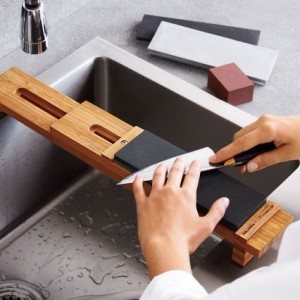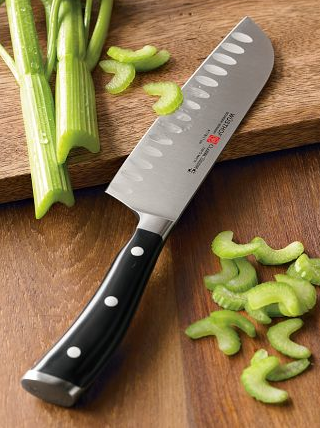If you are looking for the best santoku knife for the money, you know there are a number of very good choices on the market today. The real question comes down to how much money you are willing to budget for a Santoku knife. There are some very good, affordable knives that will last you a number of years and will perform quite well. There are also, much better quality knives that cost more money but that will last you for decades. The reviews below cover both ends of the spectrum and hopefully you will find the right knife for you.
A Santoku knife is a Japanese knife that is perfect for chopping, dicing and mincing. These knives have become extremely popular with chefs around the world due to their precision slicing and ease of use, and the tapered ground edges help in cutting very thin slices of meat without allowing the meat to stick to the knife.

The Shun Ken Onion 7-Inch Santoku Knife is considered one of the best on the market and an industry standard when it comes to a santoku knife. Although one of the most expensive santoku knife’s on the market, it is with good reason. The Ken Onion santoku knife–styled after the classic Japanese cook’s knife–features a sharp 7-inch blade that comes in handy when preparing a wide range of cuisine, anything from fine Asian to modern American. Use it to quickly and easily chop, cube, slice, and dice. The blades are thinner to make the fine slicing possible, but they will chip more easily when encountering hard objects such as a bone. When used properly, they rate very highly.
Good quality, polarizing design
It is thin, slices well and makes good rocking cuts. I don’t chop with it at all and the core steel is brittle and develops small chips rather often just with rocking cuts. Because the steel is hard it keeps a sharp edge for a long time, downside is it takes more effort to sharpen. It is worth the lower price I paid but I wouldn’t pay over 150 for it because of the chipping and I would definitely recommend handling it before buying to see if it fits your hands and gripping style.” – Amazon user review
If you truly prefer the feel of the heavier German knives but want the benefit of a Santoku knife, then the very popular German company, Wusthof, may have the perfect knife for you. The Wusthof Classic 7-Inch Hollow Edge Santoku Knife is a Japanese-style cook’s knife designed for chopping, slicing, and dicing. The alternating hollows on the blade’s sides prevent food from sticking. Receiving 5 stars from over 250 reviewers, this knife does not disappoint, if you want the classic Wusthof feel. Not quite as razor sharp-edged as the Shun knives, it still performs exceptionally well.



 Kitchen knives are a necessity for every home, and there a literally thousands of brands, shapes and sizes to choose from, depending on one’s needs, uses and preference. However, it is all about sharpness, durability and convenience, and the
Kitchen knives are a necessity for every home, and there a literally thousands of brands, shapes and sizes to choose from, depending on one’s needs, uses and preference. However, it is all about sharpness, durability and convenience, and the